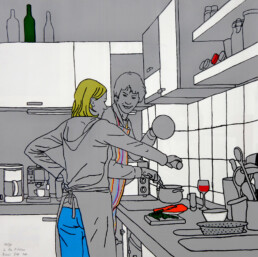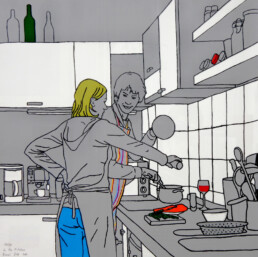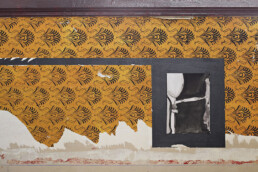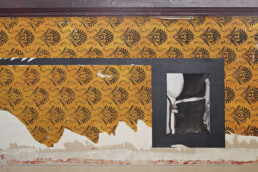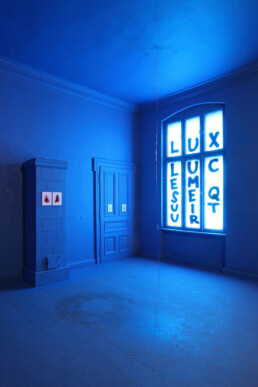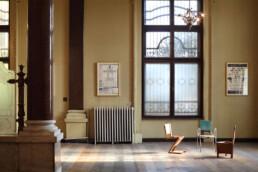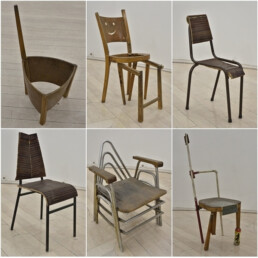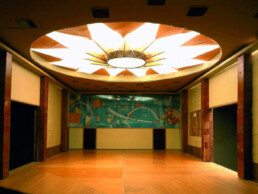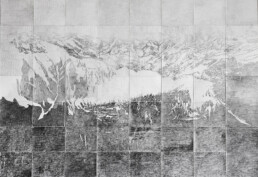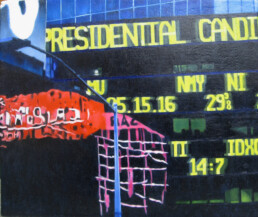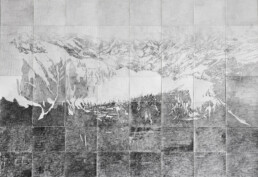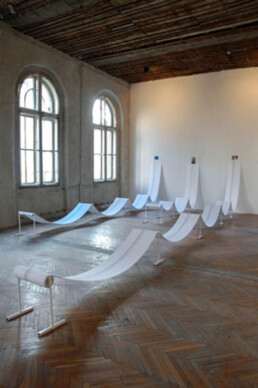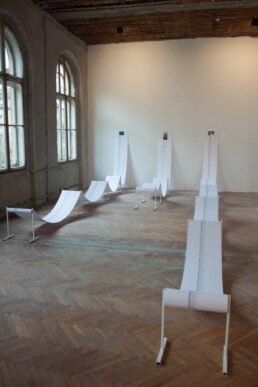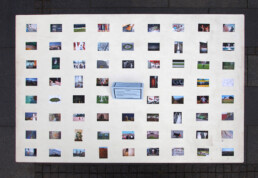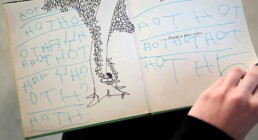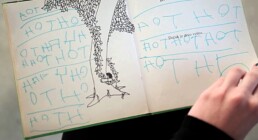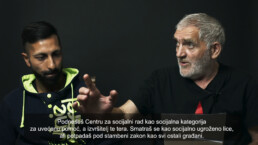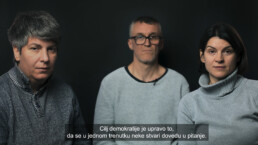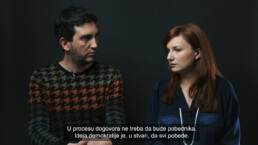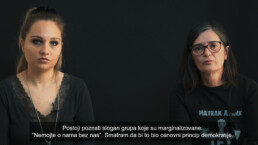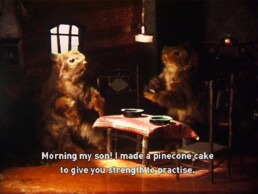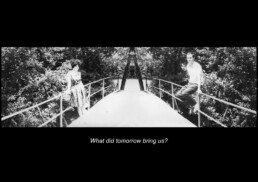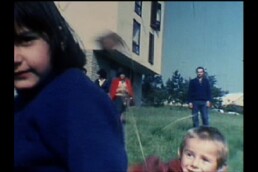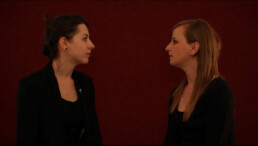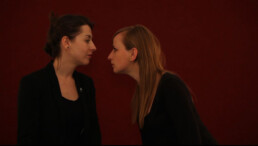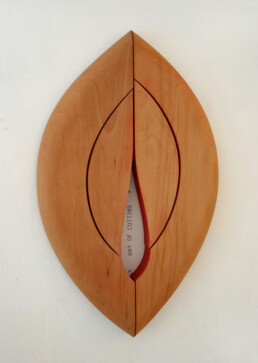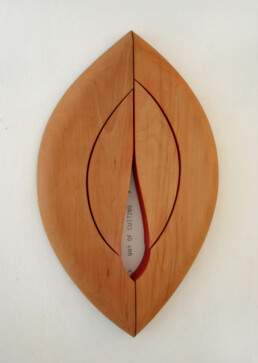Zsolt Kovács
ŽOLT KOVAČ (1975)
In the Kitchen
screen print
67 cm x 67 cm
2011
In the Kitchen
screen print
67 cm x 67 cm
2011
The work In the Kitchen belongs to the Empty Time Series, first exhibited at the 50th October Salon in 2009. The images in this series show segments of everyday leisure activities. The relationship between man and the passage of time is deliberated on, as well as man’s relation to the concept of leisure as a potential basis for a better quality of life. The series exhibited at the October Salon was done in the technique of oil on aluminium, while the work in the Collection was realized in the screen-printing technique.
The work In the Kitchen, as part of the Empty Time Series, is a segment of a desirable daily routine – the time spent preparing meals, the activity often performed mechanically and without joy. A moment of pleasure and happiness, the feeling of serenity and fulfilment are presented and they are noticeable in all the scenes in the series, through the refined drawing and vibrant colour accents. The constant dashing from one activity to another is the result of our superficial attitude towards leisure time. Paradoxically, a filled portion of time often seems to us to have been empty – when we look back at it. In the whirlwind of endless daily activities and commitments, the high-quality state of creative obsession rarely occurs. The feeling of presence and liveliness arises when there is no rush and empty time is spent in leisure or doing daily home activities.
© Cultural Centre of Belgrade, October Salon Collection and the artist
Gift Contract: III-5-290/1/25.9.2014.
Inventory No. 1353
Photo: Courtesy of the artist
Selected Bibliography:
50th October Salon, Circumstance. Cultural Centre of Belgrade, 2009
ABOUT THE AUTHOR:
Žolt Kovač (1975, Pančevo, Serbia). After graduating from the Mathematical Grammar School, he studied at the Faculty of Fine Arts in Belgrade, Painting Department, from which he received his master’s degree in 2002 and a doctorate in 2016. From 2000 to 2002 he attended the School for History and Theory of Images at the Centre for Contemporary Art in Belgrade. His works have been presented at over 20 solo and a number of group exhibitions in the country and abroad (Slovenia, Germany, Austria, Norway, Poland, Slovakia, Hungary, France, Czech Republic, Estonia, Greece, Russia, Macedonia). He works as a professor of vocational studies at the College of Vocational Studies – Belgrade Polytechnic; a co-founder and editor of the Supervizuelna on-line magazine for contemporary art (www.supervizuelna.com); engaged in graphic design and other creative activities. Lives in Belgrade. More information at https://zoltkovac.com/
Jukka Korkeila
JUKKA KORKEILA (1968)
Nothing Is a Secret (Rain Maker, Patterns, Toast and Cock)
spatial installation, gouache on paper
variable dimensions (3 pcs)
2012
Lux Lucem Sequitur
installation of ceramic tiles
variable dimensions
2012
Nothing Is a Secret (Rain Maker, Patterns, Toast and Cock)
spatial installation, gouache on paper
variable dimensions (3 pcs)
2012
Korkeila boldly breaks through boundaries in both the content of his paintings and drawings and his treatment of the tradition of painting. The main subject is the body. The artist confronts the viewer with images of the phallus, causing an uncomfortable feeling and disgust. His works express a bizarre sense of humour, balancing on the border between imagination and reality, exploring male sexuality with a dose of cynicism and sincerity that we rarely experience. Drawings and watercolours have a strong way of expression, both in colour and structure. Since the spatial concept is important in the presentation of works, the artist often, as was the case here, spreads the contents from the paper to the walls, and it is often a complete visual experience. The works were exhibited at the 53rd October Salon.
© Cultural Centre of Belgrade, the October Salon Collection and the artist
Gift Contract:
Inventory No. 204
Photo: Milan Kralj, installation view 53rd October Salon, Ana Kostić
Lux Lucem Sequitur
installation of ceramic tiles
variable dimensions
2012
Jukka Korkeila’s spatial installation was made as a site-specific work in the building of the former Geozavod, at the 53rd October Salon in Belgrade. In order to find a catalyst for his creative process, during his stay in Belgrade, he set out in search of a spiritual advisor – someone with paranormal abilities to talk to the “dead”. The research led the artist through numerous mysterious encounters and interesting dialogues that directed him to perform, as he himself said, a non-physical work in the premises of the Geodetic Institute. The spatial installation Lux Lucem Sequitur in the closed space-time continuum of the Geodetic Institute, showed scenes in the corner of the eye and silent echoes penetrating through the porous veil between the physical and spiritual worlds.
Jukka Korkeila’s work made in situ, like other works at the exhibition, sought to establish a relationship between the notion of space (physical and social) – as an existing and static state, and place – as temporary, changeable and dependent on social processes. Most artworks made in situ without a desire to spectacularize or commodify the space, provided a situated and motivated visual and conceptual commentary on their own physical, perceptual and narrative characteristics.
© Cultural Centre of Belgrade, the October Salon Collection and the artist
Gift Contract:
Inventory No. 205
Photo: installation view 53rd October Salon, Ana Kostić
Selected Bibliography:
53rd October Salon, Good Life: Physical Narratives and Spatial Imaginations. Cultural Centre of Belgrade, 2012
ABOUT THE AUTHOR:
Jukka Korkeila (1968, Hämeenlinna, Finland) graduated from the Finnish Academy of Fine Arts. He has presented his works at numerous solo and group exhibitions in Finland and abroad. In his works, Korkeila breaks through boundaries in both the content of his images and his treatment of the tradition of painting. He delicately, but also explicitly, explores a wide range of emotions – from humour to disgust, and from despair to hope. His paintings are equally rough and fragile, with a strong tension between general opinion and personal expectations and illusions. He represented Finland at the Sao Paulo Biennale in 2004 and participated in the Argentina Biennale in 2014, had solo exhibitions at the Moderna Museet in Stockholm and throughout Scandinavia. He lives and works in Helsinki and Berlin.
Karsten Konrad
KARSTEN KONRAD (1962)
Musical Chairs – Reise nach Jerusalem (Voyage to Jerusalem)
installation, wood, metal
variable dimensions (9 psc)
2012
o.T. (Ohne Tito)
installation, plywood, plastic, metal, wood, cardboard, lights
165 cm x 150 cm x 60 cm
edition: 1
2005
Musical Chairs – Reise nach Jerusalem (Voyage to Jerusalem)
installation, wood, metal
variable dimensions (9 psc)
2012
A series of installations – objects titled Reise nach Jerusalem was created as one of the two site-specific works Karsten exhibited at the 53rd October Salon (GOOD LIFE – Physical Narratives and Spatial Imaginations, 2012). The main material he used for both works, Reise nach Jerusalem and Rialto Belgrade, was demolished furniture or pieces of furniture from different periods, which he found in the Geozavod Building, where the Salon was held. For the Rialto Belgrade Installation, he received the Cultural Centre of Belgrade’s Award at the 53rd October Salon.
Unfortunately, the mentioned installation was removed next time the Geozavod space was used by new temporary users, although the author had donated it to the October Salon Collection.
Karsten Konrad’s art is based on the physical and narrative recycling of objects that he shapes into abstract sculptures, transforming spaces and creating new architectural models. The title of the work was inspired by the name of the game of chairs, which in German is called Reise nach Jerusalem. This game is also called “Musical Chairs” and there is always one fewer chair than players. During the exhibition, chairs were arranged in groups of 3 inside the building of Geozavod. Transforming physical objects, disassembling and reassembling them, Konrad constructs new narratives and meanings, and the authenticity of the material remains visible even after the modifications were made.
© Cultural Centre of Belgrade, October Salon Collection and the artist
Gift Contract: III-15-241/26.11.2012.
Inventory No. 1370
Photo: Milan Kralj, installation view 53rd October Salon, Ana Kostić
Selected Bibliography:
53rd October Salon, Good Life: Physical Narratives and Spatial Imaginations. Cultural Centre of Belgrade, 2012
o.T. (Ohne Tito)
installation, plywood, plastic, metal, wood, cardboard, lights
165 cm x 150 cm x 60 cm
edition: 1
2005
The work o.T. (Ohne Tito) is one of four works created for the international exhibition SITUATED SELF: Confused, Compassionate and Conflictual, held at the Salon of the Museum of Contemporary Art in Belgrade and the Helsinki Art Museum in 2005. The works are the result of Karsten’s research conducted for the exhibition. During his first visit to Belgrade, he researched in the history of the city and Serbian architecture in the 20th and early 21st centuries. The sculpture – model o.T. (Ohne Tito) represents the interior of the main hall of the building of the Federal Executive Council (today the Palace of Serbia) reconstructed on the bases of photographs of two opposite walls of the salon. As the artist points out, he found these photographs in two different sources, a book from the 1970s, illustrated with colour photographs of the capitals of Europe, and an article about the cultural potential of Belgrade in the Swedish magazine for design Wallpaper, from 2005, where the Main Salon of the Federal Executive Council Building is listed as one of the benchmarks of Yugoslav modernist design. Using cheap materials and scraps, Karsten tried to capture the charm of this, as he called it, ‘modern-baroque-feudal-socialist room/gallery’. The artist’s sense of humour is manifested in the play with materials, meanings, aesthetics and words. The title o.T. (Ohne Tito) is a play on words – in German, o.T. is an abbreviation for the term ‘Untitled (Ohne Titel)’ while the second part in parentheses translates as ‘Without Tito (Ohne Tito)’, which raises questions about the position, importance, preservation, treatment and attitude towards Yugoslav architectural heritage, which reflects the general climate of socialist modernism from today’s perspective of a failed utopian idea.
The work was exhibited in 2019 at the artist’s solo exhibition Submarines & Turbotowers at the Podroom Gallery, together with his new works inspired by the history and urban development of Belgrade and the concept of turbo architecture, very present in Serbia during the 1990s and early 2000s.
© Cultural Centre of Belgrade, the October Salon Collection and the artist
Gift Contract: III-5-96/11.3.2020.
Inventory No. 1670
Photo: Courtesy the artist
Selected Bibliography:
SITUATED SELF: Confused, Compassionate and Conflictual. Salon of the Museum of Contemporary Art, February – March 2005. Mika Hannula, Branislav Dimitrijević Museum of Contemporary Art, Belgrade, and Art Museum Tennis Palace, Helsinki, 2005
ABOUT THE AUTHOR:
Karsten Konrad (1962, Würzburg, Germany) graduated in sculpture from the University of the Arts in Berlin and continued his education at the Royal Academy of Arts in London. From 2010 to 2013, he was a Visiting Professor at the Sculpture Department of the University of the Arts in Berlin and the China Academy of Arts in Hangzhou. In 2012 he received the Cultural Centre of Belgrade’s Award. He makes objects and installations from materials found at dumps and flea markets, emphasizing sculptural transformations of architecture. His works have been presented at numerous solo and group exhibitions across Europe, North America and Asia. Since 2016, he has been a full professor at the Sculpture Department of the University of the Arts in Berlin. Based in Berlin. More information at http://karstenkonrad.de/
Nataša Kokić
NATAŠA KOKIĆ (1979)
Untitled
oil on canvas
35 cm x 40 cm
2006
Drawing (Untitled)
drawing, pencil on paper
230 cm x 400 cm
2011
Untitled
oil on canvas
35 cm x 40 cm
2006
The work Untitled belongs to the series of paintings Target Market, which presents city and urban landscapes that abound in socio-political issues of everyday life in the time of globalized society.
The Target Market Series was presented at the 47th October Salon, Art, Life and Confusion, in 2006.
The title is taken from the sentence “You are a target market“, from Grant Gee’s documentary film Meeting People Is Easy. Sixty images of urban landscape, dominated by structures, buildings and advertisements, speak of the subversive messages of the consumer society. The marketing that differentiates target groups in the vocabulary of a capitalist consumerist society is a strategy that “breaks down” a large market into smaller segments in order to concentrate on a particular group of customers within a particular segment. The urban landscapes in the paintings are in fact human creations and spaces of capitalist strategies that lead to alienation and mentally impoverished space.
© Cultural Centre of Belgrade, October Salon Collection and the artist
Gift Contract: III-5-221/1/14.8.2014.
Inventory No. 1336
Photo: Milan Kralj
Selected Bibliography:
47th October Salon, Art, Life and Confusion. Cultural Centre of Belgrade, 2006
Drawing (Untitled)
drawing, pencil on paper
230 cm x 400 cm
2011
The work Drawing, of large dimensions, is a picture of a landscape, this time deprived of the visible influence of man, without clear indications of what time of the day or which season it is. The work consists of smaller formats of abstract pencil drawings, which the artist composed in a larger surface.
It is a process that represents an accumulated habitat that, modelled in this way, contains experiences of the past and present and hints of the future. It shows a personal world to which we always return, the unfulfilled desires cut at the roots, the places where we were growing up, the things we love.
The frequent theme of landscape in the work of Nataša Kokić becomes a metaphysical space for thinking about the society in which we live.
The spread of the landscape to infinity in all directions, beyond the paper, its flatness and repetition of shapes emphasize the credibility in time and space. The light source in the work is diffuse and obscure. Constant thinking about changing of the shapes and angles, and the amount of dark surfaces, makes the landscape retain its “natural” appearance. Distant and hazy, it is our private, accumulated, conceptual habitat, which exists in our minds, while it reflects the forms of the outside world. At first glance, empty areas are still fertile ground. Tactile and fragile, unstable, they are there to help us develop ideas and find inspiration. They are open to suggestions, changes, communication.
© Cultural Centre of Belgrade, October Salon Collection and the artist
Purchase Contract: III-5-486/1/22.12.2014.
Inventory No. 1386
Photo: Courtesy of the artist
Selected Bibliography:
The Finalists of the Dimitrije Bašićević Mangelos Award, Jun. 16 – Jul. 4, 2014, Exhibition Catalogue, Remont Gallery, Belgrade, 2014
ABOUT THE AUTHOR:
Nataša Kokić (1979, Belgrade, Serbia) graduated in painting (2005) and received her master’s degree (2010) and doctorate (2019) from the Faculty of Fine Arts in Belgrade. She has had group and solo exhibitions in the country and abroad; her works are part of the collections of institutions in Serbia, Austria, Switzerland, Sweden and Denmark (Belgrade Cultural Centre of Belgrade, Kruševac Art Gallery, Haos Gallery; Stockholms lans landsting, Siemens Vienna, Ernst Hilger Contemporary, Vanløse Kulturhus – Copenhagen, etc.). She has won various awards and commendations for drawing, including: Dimitrija Bašićević Mangelos Award (2014), Vladimir Veličković Award (2013), KulturKontakt Austria and Henkel Art Award (2008), etc. She has participated in many international residency programmes, such as Nordisk Kunstnarsenter Dale residency, Sunnfjord, Norway (2015); International Studio and Curatorial Program ISCP, New York, USA, (2014); Kunst Kamers Rotterdam, Home is where you hang your Art, Rotterdam (2011); etc. More information at cargocollective.com/natasakokic
LUKA KNEŽEVIĆ – STRIKA
LUKA KNEŽEVIĆ – STRIKA (1983)
Images / Words
installation, digital print
variable dimensions
2014
Swap
installation
variable dimensions (160 cm x 90 cm x 50 cm)
2014
Images / Words
installation, digital print
variable dimensions
2014
The work Images/Words is one of four works the author exhibited at the 55th October Salon 2014 (Disappearing Things), at the invitation of Curators Vanessa Miller and Nicolaus Schafhausen. Responding to the given concept of the Salon, the artist examines the survival and treatment of visual material on the Internet, the changes in the meaning of images and their further use, after they have been uploaded to various internet platforms and ceased to be works of the artist-author.
…“In the work Images/Words, I search for my photographs I’ve published on different Internet platforms at different times, which became images/words as other authors on Tumblr use them.
The photographs on display were taken directly from this context, presented as printed screenshots of the blogs where I found them – below each photo, the corresponding re-blogs/comments/likes are printed – and they are a kind of the ‘snapshot’ of the place where the images, having ceased to be my works, become words in the evolving vocabulary of a new language.”
Luka Knežević – Strika, taken from the Catalogue of the 55th October Salon
© Cultural Centre of Belgrade, the October Salon Collection and the artist
Purchase Contract: III-5-156/25.5.2016.
Inventory No. 1417
Photo: installation view 55th October Salon
Selected Bibliography:
55th October Salon, Disappearing Things. Cultural Centre of Belgrade, 2014
Swap
installation
variable dimensions (160 cm x 90 cm x 50 cm)
2014
Swap is one of four works the author exhibited at the 55th October Salon in 2014 (Disappearing Things), at the invitation of Curators Vanessa Miller and Nicolaus Schaffhausen. The work was realized as a project exploring the value people assign to printed photographs, and besides Belgrade, it was realized in Skopje, Herceg-Novi, Zlarin, Novi Sad, Regensburg, Malmö, Mostar, Casablanca…
“Most photographs are never looked at after they have been taken. Likewise, most of the photographs one views only exist while the screen is on. Printed photographs generally exist only as propaganda material.
…A selection of small (5 cm x 7 cm) photographs are arranged on a big table in a busy open public space (e.g., a square, promenade…). I put an instruction in English and the local language on the table, stating that anyone is welcome to take any photo they like, but they should leave another item to replace it. If possible, I withdraw, leaving the audience to handle the situation themselves. This produces a small barter– swap economy.”
Luka Knežević – Strika, taken from the Catalogue of the 55th October Salon
The table from the swap in Belgrade was the only one preserved in the final phase, when many photographs had become objects. The table itself, since the moment it was photographed after the exchange, have become a permanent document of the Belgrade’s performance, but also of the transformation and decay of the objects that, having replaced the photographs, took their place.
© Cultural Centre of Belgrade, the October Salon Collection and the artist
Gift Contract: III-5-129/1.6.2020.
Inventory No. 206
Photo: Courtesy of the artist
Selected Bibliography:
55th October Salon, Disappearing Things. Cultural Centre of Belgrade, 2014
ABOUT THE AUTHOR:
Luka Knežević – Strika (1983, Belgrade, Serbia). He is a co-founder of the Belgrade Raw Photo Collective. He has exhibited in the country and abroad; co-curated an annual programme of the Cultural Centre of Belgrade’s Artget Gallery; one of the initiators of the “MultMadeira” artist-in-residence programme in Portugal. He explores the ways in which the use and position of photography – as the common language of everyday life, changes in the time of its universalization. As a documentary photographer, he examines the unintended consequences of manipulating the visual identities of the urban environment.
Kiosk
KIOSK
Kiosk Dialogues
video interviews
9′
2010
Performing Democracy
video
2h 42′ 4″
2020
Kiosk Dialogues
video interviews
9′
2010
The work was presented at the 51st October Salon: The Night Pleases Us.
It was conceived as a communication platform, where the participants were co-creators and co-authors. They themselves chose how they would be presented, what they would say and how, fully aware that their statements would become integral parts of the artwork intended for public presentation.
It was carried out at the 51st October Salon in Belgrade in 2010. The participants were pupils of several Belgrade secondary schools: Electrical Engineering School Nikola Tesla; School of Beauty Care; the Third, Sixth and Twelfth Belgrade Grammar Schools. They were all asked to answer the same question, “What is your most impressive childhood memory?”
In October 2010, during the Salon, Kiosk Dialogues were broadcast on Studio B and RTS televisions.
The project was realized in cooperation with the Cultural Centre of Belgrade and Hartefakt Foundation.
© Kiosk and Cultural Centre of Belgrade, the October Salon Collection and the artists
Purchase Contract: III-5-519/24.11.2014.
Inventory No. 1391
Photo: still from the video work
Performing Democracy
video
2h 42’ 4″
2020
The work is created as a participatory dialogic platform and realised in the form of an experimental video forum in which the meaning and condition of democracy in contemporary society are considered. Starting from the question “What is democracy?,” the work includes the thoughts of 27 groups of interviewees, that is, 59 citizens of Serbia in total, who articulate, through their answers to this question, their views on the basic concepts integrated into the idea of democracy, the state democracy is currently in, in and beyond our country, as well as possible alternatives. Striving to include interlocutors in this dialogue who have quite different experiences, as well as those coming from different parts of the ideological spectrum, the project comprises representatives of citizens’ initiatives, movements, and organisations, representatives of political parties as well as Serbian citizens of different professions. In this way, the project explores different positions within the Serbian society, using a common experimental forum in which all participants have equal rights to be heard.
Interviewees: Slavoljub Kostić and Goran Jakovljević (participants of environmental protests in Bor); Jelena Miletić, Dragan Stojmenović, and Goran Milenković (Informal Communication Centre Nemušto/Mute in Bor); Božidar Savić (retiree) and Zorana Pavlović (independent artist); Zoran Lutovac and Dragana Rakić (Democratic Party); Milovan Pavlović (disability pension user) and Denis Ferizović (citizen of Serbia); Prof. Tamara Milenković Kerković, PhD, and Jugoslav Kiprijanović (Serbian Movement “Dveri”); Jelena Simić (assistant professor at the Faculty of Law, Union University) and Agata Milan Đurić (human rights activist); Jugoslav Ristić (president of the Alliance of Independent Trade Unions in Kragujevac), Zoran Marković (president of the FCA Fiat Chrysler Automobiles Independent Trade Union in Serbia), and Dragan Ilić (president of the Zastava Arms Independent Trade Union); Snežana Žujković (specialist of gynaecology and obstetrics) and Aleksandar Dukić (gynaecologist and obstetrician); Ljiljana Nadoveza (citizen of Serbia) and Ozren Nadoveza (unemployed); Vladimir Marović and Predrag Voštinić (Local Front); Marija Perković (worker) and Dženeta Agović (activist and president of the Impulse Organisation from Tutin); Marija Marinković, Danijel Dašić, and Mladen Jovanović (National Coalition for Decentralisation); Dobrica Veselinović and Radomir Lazović (Do Not Let Belgrade Drown); Vesna Vojvodić Mitrović and prof. Zoran Stojiljković, PhD (United Branch Trade Unions “Independence”); Milena Repajić and Ivan Velisavljević (The Party of Radical Left); Radomir Ćirilović and Vladeta Jovanović (“Prosperity” Association for the Protection of Consumer Rights); Iva Marković and Miloš Baković Jadžić (Right to Water Initiative); Marija Jakovljević and Galina Maksimović (Reconstruction Women’s Fund); Nataša Tasić Knežević (opera soloist at the Serbian National Theatre in Novi Sad) and Saša Knežević (pianist); Nevena Martinović and Filip Milošević (SHARE Foundation); prof. dr. sci Slavica Đukić Dejanović and prof. Predrag Marković, PhD (Socialist Party of Serbia); Milinka Minja Nikolić, Marica Stamenković, and Milijana Živković (activists, Balkan Mountains); Tanja Marković (activist) and Nebojša Milikić (member of the No to Rehabilitation Initiative); Olja Nikolić Kia (member of the Transbalkan Solidarity and Push Back Map collectives) and Teodora Jovanović (anthropologist); Tara Rukeci and Branislav Markuš (Zrenjanin Social Forum); Slađana Radivojević, Zorica Krunić, and Dušan Jović (Trstenik Theatre).
© Cultural Centre of Belgrade, the October Salon Collection and the artist
Purchase agreement: III-5-281/08.10.2021.
Inventory No.
Photo: video frame, courtesy of the artists
ABOUT THE AUTHORS:
The Kiosk Platform for Contemporary Art acts in the fields of contemporary art and culture, with the aim to create specific art dialogue platforms and enable the cooperation of artists and cultural workers with the widest audience. Kiosk initiates its works, exhibitions and projects believing that innovative art practices contribute to openness and enable a better understanding of social and political issues that are part of everyday life in modern societies. Kiosk was founded by artist Ana Adamović and art historian Milica Pekić in 2002.
Kiosk is a co-founder of the Independent Cultural Scene of Serbia Association and the Kooperativa Regional Platform for Culture. More information at www.kioskngo.net
Anssi Kasitonni
ANSSI KASITONNI (1978)
Gliders
video
13’36”
2005
Gliders
video
13’36”
2005
The video-works Flying Squirrels and Planet of Sexes were screened at the 53rd October Salon, Good Life.
A young squirrel who loves rock and roll, American cars and skateboards does not want to continue the long-lasting family tradition of dressing in a flying squirrel to protect its forest. In terms of the narrative and rhythm, this is Kasitonni’s most traditional story, which hammers its message into the viewer’s brain with unstoppable force. There is some special equipment in this film, and musical interludes, and animation, and real cars, and changing perspectives. The film Flying Squirrels could easily be interpreted as an autobiographical story of a descendant of an entrepreneurial family who has become an artist.
Anssi Kasitonni, exhibition catalogue of 53rd October Salon
© Cultural Centre of Belgrade, the October Salon Collection and the artist
Gift Contract:
Inventory No. 202
Photo: still from the video work
ABOUT THE AUTHOR:
Anssi Kasitonni (1978, Sahalahti, Finland) is a skateboarder and an award-winning artist from Finland. He makes films, drawings, sculptures and music. He mainly deals with eternal topics, such as morality, love, death, generation gap, sex and, of course, submarines. The ideas are epic and the films are simple. They create their own world that always tells us a lot about ours. He won the Ars Fennica Award in 2011. He does not consider all his works to be masterpieces, but sometimes they are. More information at www.anssikasitonni.com
Dejan Kaludjerović
DEJAN KALUDJEROVIĆ (1972)
What Did Tomorrow Bring Us?
slide projection with sound
variable dimensions
edition: 2/5
2011
1st of May 1977
two-channel sound installation
13’15”
2014
What Did Tomorrow Bring Us?
slide projection with sound
variable dimensions
edition: 2/5
2011
The installation What Did Tomorrow Bring Us? is a slide projection of photographs of the artist’s parents, accompanied by the sound of a flowing river. The projection consists of two merged photographs. One shows the artist’s mother, photographed by her husband and in the other is the father, photographed by his wife. Joining them into one whole, he connects the documentary with a construction, the present with the past. The grammatically distorted chronology of the work’s title suggests the collapsing of the past, present and future, inviting the viewer to examine the authenticity of both the question and the projection.
The work deals with the relationship between the present and the past through the image of a couple and the paradoxical question of what tomorrow brought to us. It also speaks of a particular historical period of Yugoslavia and can be understood as an allusion to the socialist and communist dream lived by the artist’s parents. “Frozen” in the picture at one particular moment, the man and the woman wonder about the future directly from their past. Although the picture seems to invite us to cross the bridge on which the couple is, the text becomes a physical obstacle for us to do so. The man’s and woman’s glances meet with the glances of the viewers and remain trapped between the mutual process of thinking and the presence of outsiders.
© Cultural Centre of Belgrade, October Salon Collection and the artist
Gift Contract: III-5-38/15.3.2014.
Inventory No. 1340
Photo: still from the video work, courtesy of the artist
Selected Bibliography:
Branislav Dimitrijević, ‟We might come from Hell, but we’re too young to tell”, Can I Change My Career For a Little Fun?, Museum of Contemporary Art, Belgrade, Belgrade, 2007, 5–10
Kristina Marberger, ‟What Did Tomorrow Bring Us?”, accompanying text for the exhibition What Did Tomorrow Bring Us?, HDLU-Karas, Zagreb, Croatia, 2012
Goran Petrović, “Nemogući identitet i nestabilnost reprezentativnih formi u radu Dejana Kaludjerovića”, Art Centrala Magazine, Podgorica, 2014, 8–9
Marina Martić, “The Kids Are Alright”, Dejan Kaludjerović, Conversations –Azerbaijan, YAY Gallery, Baku, Azerbaijan, November 2014, 11–13.
1st of May 1977
two-channel sound installation
13’15”
2014
It is a deconstruction of a family film depicting an act of violence whose cause remains unknown. It focuses on a scene where a boy is throwing a rock at a girl. The artist analyses the event from his early childhood and invites his family members to recall the event.
The work was exhibited at the 55th October Salon, and received the October Salon Award.
The original recording was divided and transferred onto 80 slides, which are repeated every four minutes, thus emphasizing the scene of violence and extending its duration. The other important segment of the installation is audio recording, the testimonies of the eyewitnesses (family members), who are talking about the event that took place in 1977. The differences in their statements testify to the subjective nature of memories and observations, which becomes evident to the viewers themselves in the process of understanding the work. The work was presented in two separate rooms: in one, audio-recordings of the eyewitnesses’ testimonies were heard, and in the other, the picture of the act of violence was shown. In this way, the artist leaves room for each viewer individually to create their own parallel scenario of the event – which itself is disputable.
The work was exhibited at the 55th October Salon: Disappearing Things, 2014
© Cultural Centre of Belgrade, October Salon Collection and the artist
Purchase Contract: III-5-420/16.12.2016.
Inventory No. 1426
Photo: still from the video work, courtesy of the artist
Selected Bibliography:
55th October Salon, Disappearing Things. Cultural Centre of Belgrade, 2014
Seamus Kealy, ‟Repositories of Unseen Impulses: A Few Notes on the Work of Dejan Kaludjerović”, Conversations, Verlag Für Moderne Kunst, Vienna, 2017, 33–39
Goran Petrović, Impossible Identity and Instability of Representational Forms in the Work of Dejan Kaludjerović, The Future Belongs to Us?, Galerie Van De Weghe, Antwerp, 2013
Walter Seidl, “Dejan Kaludjerović: Realities of a Child’s Mind” Can I Change My Career For a Little Fun?, Museum of Contemporary Art Belgrade, Belgrade
О АУТОРУ:
Dejan Kaludjerović (1972, Belgrade, Serbia) graduated and received his master’s degree from the Faculty of Fine Arts in Belgrade, and completed his specialist studies at the Academy of Applied Arts in Vienna. In 2010, the Austrian government awarded him honorary citizenship for deserving artists/citizens. In his work, Kaludjerović most often questions responsibility and manipulation, as well as the way mass media, education systems, or family contexts affect the society. His work often focuses on the exploration of the dominant central image of Western society, obsessed with violence, as well as on the structures and mechanisms of capitalism. His works are part of many private and public collections; he has exhibited at numerous solo and group exhibitions in Europe, America, Australia and Asia. He lives and works in Belgrade and Vienna. More information at dejankaludjerovic.net
Adela Jušić i Lana Čmajčanin
ADELA JUŠIĆ (1982),
LANA ČMAJČANIN (1983)
I Will Never Talk about the War Again
HD video, colour, sound
9’42”
2011
I Will Never Talk about the War Again
HD video, colour, sound
9’42”
2011
Adela Jušić and Lana Čmajčanin exhibited their works independently at the 54th October Salon: No One Belongs Here More Than You, which dealt with visual and discursive methodologies that explore and show the (in)human nature. Adela Jušić presented the work Ride the Recoil, photographs and sound, and Lana Čmajčanin the work 166987 Stitches, embroidery.
Lana Čmajčanin’s and Adela Jušić’s video performance draws attention to the post-war situation, in which the past war in the former Yugoslavia is a recurring theme. Personal experience shows that it is impossible not to talk about the war in everyday life. In this performance, two artists try to express a full range of emotions related to the war, but also to point to different positions in talking about the war; the way how nationalist political parties constantly refer to the war in the media – in order to maintain power and intolerance between the peoples of the former Yugoslavia on national grounds.
Is it possible not to talk about the war?
Why are we doing this?
When will we stop?
Will we ever stop?
Should we stop?
Camera: Ervin Prašljivić
Sound: Lana Čmajčanin and Adela Jušić
Editors: Lana Čmajčanin and Adela Jušić
Language: Bosnian
Subtitle: English
Special thanks to Sloven Anzulović
© Cultural Centre of Belgrade, the October Salon Collection and the artists
Gift Contract: III-5-218/1/14.8.2014.
Inventory No. 1339
Photo: still from the video work
ABOUT THE AUTHORS:
Adela Jušić (1982, Sarajevo, Bosnia and Herzegovina) graduated from the Academy of Fine Arts in Sarajevo in 2007, and received a master’s degree in democracy and human rights in Southeast Europe from the Universities of Sarajevo and Bologna. Selected exhibitions: Manifesta 8, Spain; Videonale, Bonn, Germany; Image Counter Image, Haus der Kunst, Munich; Balkan Insight, Pompidou Centre in Paris… In 2010 she won the Award for the best young Bosnian artist, then the Henkel Award and a special prize at the 54th October Salon. She is a co-founder of the Crvena [Red] Association for Culture and Arts and co-creator of the online archive of the antifascist struggle of women of Bosnia and Herzegovina and Yugoslavia. More information at https://adelajusic.wordpress.com/
Lana Čmajčanin (1983, Sarajevo, Bosnia and Herzegovina) graduated in sculpture and received a master’s degree from the Academy of Fine Arts of the Sarajevo University, currently is a PhD student at the Academy of Fine Arts in Vienna. She is a co-founder of the Crvena [Red] Association for Culture and Arts. Lives and works in Sarajevo and Vienna. More information at https://www.lanacmajcanin.com/
Zdravko Joksimović
ZDRAVKO JOKSIMOVIĆ (1960)
I Do Not Believe Words
sculpture, wood
76 cm x 45 cm x 8,5 cm
2012
I Do Not Believe Words
sculpture, wood
76 cm x 45 cm x 8,5 cm
2012
The sculpture I Do Not Believe Words belongs to a group of works in which the artist, through a personal and intimate scenography, with a dose of fine irony, interprets the environment in which he lives and creates. By its very title, he evokes the viewer’s associations and literally describes the essence of the work itself in those simple words.
Metaphors and metonymies, rhetorical figures of speech help the author to organize thoughts and feelings in a way that transcends the personal. Although Joksimović’s sculptures radiate with their formal potential, vitality and association, by naming the works he adds a closing, poetic element to his compositions, rounding them off into a solid whole. The titles represent the artist’s loud thinking about the idea and intention of the work of art, but also about the doubts he didn’t manage to resolve completely.
© Cultural Centre of Belgrade, the October Salon Collection and the artist
Purchase Contract: III-5-383/16.11.2016.
Inventory No. 1457
Photograph: Courtesy the artist
Selected Bibliography:
Zdravko Joksimović: Lečenje umetnošću, Nov. 18 – 29, 2017, text by Ivona Fregl, Lucida Gallery, Belgrade, 2017
Zdravko Joksimović: Skulpture i crteži, Apr. 19 – 29, 2013, catalogue for the solo exhibition, RIMA Gallery, Kragujevac, 2013
Zdravko Joksimović, May 2011, catalogue of the solo exhibition, Faculty of Fine Arts, Atelier DADO – Cetinje, Montenegro, 2011
ABOUT THE AUTHOR:
Zdravko Joksimović (1960, Buče, Montenegro) graduated and received a master’s degree from the Faculty of Fine Arts in Belgrade, under Professor Nikola Janković. In 1987 he became a member of ULUS (Association of Fine Artists of Serbia) and in 1992, a professor at the Sculpture Department of the Faculty of Fine Arts in Belgrade. He is a representative of the art movement known as New Belgrade Sculpture in the late 1980s and early 1990s. Since his first solo exhibition at the Gallery of the Belgrade Youth Centre in 1985, he has presented his work at 40 solo exhibitions in the country and abroad and numerous group exhibitions in Europe. He is a recipient of the Politika Award for the best exhibition in 2016. More information at http://www.zdravkojoksimovic.com/
